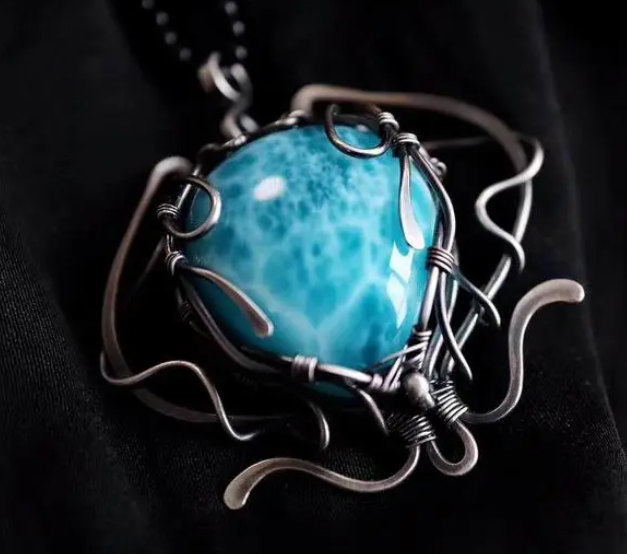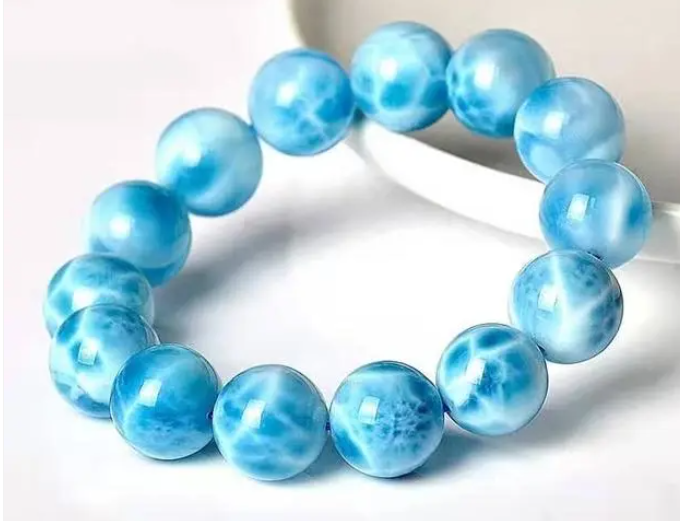What is sea patterned stone? Gemstone efficacy and function
Larimar, also known as Larima, is a unique copper-bearing petolite, belonging to the category of emerging gemstones. Petolite, a hydroxyl-bearing sodium calcium silicate mineral, exhibits a blue variety when rich in vanadium or copper elements, known as blue petolite. Its English name “Peetolite” originates from Greek, meaning “tightly bound and resistant to chalking.” Meanwhile, “Larimar” stems from the Spanish word for “sea” (mar), earning it the title of “Heart of the Sea.”
In Japan, Larimar holds a status comparable to sugilite, both being treasured gemstones. In China, Larima was once hyped up to astronomical prices. This gemstone is renowned for its wave-like flowing patterns, symbolizing the surge of knowledge and wisdom.
Morphology of Larimar
Larimar Larimar is a product of hydrothermal activity, formed by the cooling and crystallization of high-temperature liquids ejected during volcanic activity. Therefore, it is often found in igneous rocks, coexisting with zeolites, prehnites, calcites, and others. It typically appears colorless, white, pale pink, or pale green, while blue crystals are extremely rare. Some scholars believe that the sky-blue color of Larimar may be due to trace amounts of copper and vanadium. Sometimes, it may also contain red or brown (iron-bearing) or gray inclusions. The closer Larimar’s color leans towards blue tones, the higher its value, resembling the shimmering waves on the sea surface.
Origins of Larimar
Larimar is primarily distributed in North America, especially Dominica, where it is considered the national gemstone. Larimar is uniquely charming with its wavy blue-white patterns and blue-green mixed with white water-wave forms. It grows in cracks and holes in volcanic rocks. Due to the limited mining area and difficult manual extraction, its production is scarce, making it highly collectible.
Efficacy and Functions of Larimar
Larimar’s energy is delicate and soft, resonating with the energy frequency of the sea, earning it the reputation of having the power to nourish the soul. It helps dissolve aggressive and competitive personalities, bringing peace. Additionally, it aids salespeople in attracting diverse clients, fostering a mindset of great love and compassion. Larimar brings energy to nourish the mind, improves interpersonal relationships, resolves misunderstandings and conflicts, enhances communication skills. It can also transform and absorb our past frustrated negative energies, bringing in a continuous flow of yin energy. Furthermore, Larimar is a guardian stone of wisdom, aiding in navigating academic endeavors.
Symbolism of Larimar
Larimar is a spiritual vein stone, symbolizing wisdom and hope, wealth and honor. It is deep, clear, romantic, and beautiful, carrying beautiful legends. Meanwhile, Larimar possesses a certain vitality, bringing tranquility and a vibrant energy field. It is also regarded as the soul of the sea, symbolizing composure, bravery, calmness, and kindness.
Maintenance Methods for Larimar
Provide Moisture: Find a sealed bag similar in size to the bracelet or pendant, place a slightly dampened makeup pad or cotton pad inside (just leaving a bit of moisture), then lay it flat in the bag, trying to keep it horizontal with the bracelet. After placing it, remove the air from the sealed bag. This maintenance method only needs to be done when not wearing the jewelry daily and not every day. Note: Providing moisture does not mean soaking in water.
Reduce Temperature: Avoid exposing Larimar to high temperatures for extended periods, especially after wearing it during the day in summer; place it in a cool place at night.
Prevent Bumps: Larimar is brittle, so avoid colliding with hard objects when wearing it to prevent cracks that could lead to internal moisture loss.
How to Select Larimar
The value of Larimar Larimar is closely related to its color. The bluer the hue, the higher the value. Among them, volcanic blue is the rarest variety with extremely high value. The most popular color on the market is sky blue, favored by high-end jewelry and collectors. Sometimes Larimar may also have a green tone, but it is less popular in the market. Additionally, Larimar develops wave patterns during the cooling process; the clearer and more striking the patterns, the higher the value. High-quality Larimar should be free of any foreign impurities, flaws, and cracks.
Colors and Grades
The colors of Larimar are caused by differences in transition elements such as copper, chromium, and vanadium. Among them, the pure sea-blue hue holds the highest value, with deep cobalt blue being the best, followed by turquoise blue, and light sky blue also being valuable. The lighter and whiter hues have lower quality. Larimar typically has a sea-blue, volcanic blue, or sky-blue base color accompanied by wave-like white patterns. Some Larimar may contain green, yellow tones, as well as impurities in red, brown, and gray-brown hues. Color, pattern, and jade-like quality are the main characteristics of Larimar. In brief, reaching top-level status in two of these characteristics already qualifies as a fine-grade piece; possessing all three characteristics simultaneously makes it an exceptional gem. Based on beautiful color and high jade-like quality, uniform, clear, and shaped patterns enhance Larimar’s appeal, with “turtle back patterns” being one of its most beautiful textures.
Price Factors
Besides grade generalization, luster, clarity, and completeness are also significant factors affecting Larimar’s price. Larimar with soft and vivid colors is more popular among collectors and buyers. Unlike diamonds and other colored gemstones, Larimar’s clarity is determined by the amount of internal flaws and impurities. Due to the presence of red-brown impurities distributed in dots on the blue base and white reticulations, factors such as completeness (e.g., mixed colors, external cracks) and clarity (e.g., black spots, yellow-green spots) become one of the main factors influencing price when purchasing.
Suitable Populations
Mental workers
Students with heavy academic loads
Emotionally unstable individuals
Irritable and temperamental people
Market Value
Larimar’s market value is severely underestimated. On the one hand, its production is very small; on the other hand, its popularity in China is not high. However, in European and American markets, Larimar sells for about three times the domestic price and remains stable. Therefore, Larimar holds high collectible value.
Why is Larimar So Expensive?
Scarce Origin: Currently, the only producer of Larimar worldwide is the Dominican Republic, and its production is very scarce, making it the national gemstone of the country.
Difficult Mining: It is only produced on a mountain named Caribben Mountain in the Dominican Republic, with a mining area of only about 15 square kilometers. Larimar is sourced from cracks and holes in volcanic rocks in this area and can only be mined manually. Furthermore, the petolite from the Larimar mine in the southern Barahona province of the Dominican Republic is the only one worldwide that has beautiful colors ranging from sky blue to light green due to its copper content and exhibits peculiar patterns resembling the shimmering surface of the sea (i.e., “turtle back patterns”).
Quality Rating of Larimar
The best color for Larimar is volcanic blue, but it is now difficult to find. The purer and deeper the blue, the higher the value; the lighter and closer to white, the lower the value. Larimar is usually opaque; when other conditions are equal, translucent (i.e., jade-like) quality is superior to opaque. The patterns should be uniform, clear, and shaped; the best are turtle back patterns; pieces without patterns or with too messy patterns have lower value. The luster should be bright; the fewer impurities, mixed colors, and ice cracks, the better. Care should be taken when distinguishing between ice cracks and natural textures.



Rose Quartz Healing for Women Anxiety Crystal Bracelet
$29.00Original price was: $29.00.$23.00Current price is: $23.00.